One, two, three and four! Four as the number of eclipses Ive observed so far in my life: this one took place in Siberia. As youll see, its been no easy task, but at the end of the day what really counts is that it turned out to be a great success, whose memories will last for a long time.
The Aug 1, 2008, solar eclipse was the my fourth one, taking into account only the eclipses Id seen the totality phase of, including the annular one of Oct 3, 2005 (detailed report), and of course that of Mar 29, 2006 (detailed report), the best Id ever witnessed. This time, the Moons shadow would start its brief journey in the polar regions of Canada, then plunge into the Arctic Ocean and soon land on the barren and clod shores of northern Siberia (Novaja Zemlja). Then, it would roam the lonely plains of Siberia from northwest to southeast, and shortly after it would skim the far end of western Mongolia and northern China, where the eclipse would die out along with the last rays of the day.
While the eclipse of March 29, 2006 took place in areas known for the stability of their climate even in spring (Libyan and Egyptian desert, southern Turkey), the situation for this one were much poorer, if not even dismal especially in the first stretch of its path. The weather prospects were to improve along the way, from North to South and from West to East, up to a fair rating in Southern Siberia and a slightly higher peak in Mongolia and China, where most of the eclipse-wiewing trips of amateur astronomers worldwide were headed for.
PLEASE NOTE: from now on in this article, times for the events are given mainly in local time (Novosibirsk time = UT + 7h in this season), and more rarely in UT.
Two important Russian cities lay almost in the center of the path of totality: Novosibirsk (pop. almost 1.5 million) and Barnaul (pop. upwards of 600 thousand). This made Southern Siberia probably the best tradeoff between chance of seeing the eclipse (barely above a not-so-shining 50%) and comfort. For this reason, I opted to join a guided tour to Barnaul organized by the UAI (Unione Astrofili Italiani, i.e. Italian Amateur Astronomer Union) , which also offered a longer and more demanding one to Western Mongolia, around 1000 km to the SouthEast of Barnaul. With hindsight, I can say my choice for Siberia was the right one, since I experienced a shoulder dislocation (from sports activities) just two weeks before departure, and certainly this would have prevented me from going to Mongolia. Heres the complete map of the path of totality with a close-up of Southern Siberia (courtesy Jay Anderson):
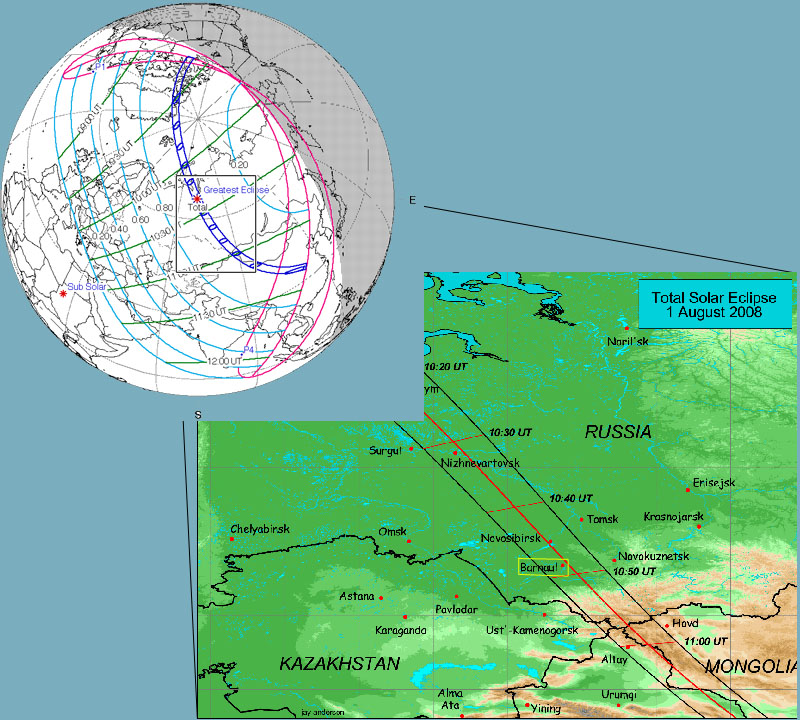
Around July 25th, a few days from depature, the weather forecast was already quite poor: almost all meteorological websites, and especially the Russian ones, agreed on cloudy and rainy weather.
On July 29th we leave for Moscow: on arrival at Domodedovo airport we are welcomed by very windy and cold weather, even for the season and by Russian standards. Anyway, theres no denying the weather didnt cooperate during the whole journey, not even in the optional tour extension to Saint Petersburg. As you will see shortly, this eclipse was far and away the most troubled one.
On July 30th we visit Moscow, a world-famous, history-laden city: together with St. Petersburg (which is even richer and awe-inspiring), they make an ideal sightseeing tour destination. In the meantime, the weather forecast keeps on being very poor, with slightly better chances for Novosibirsk than for Barnaul: this gives me a very unpleasant feeling, which pushes me to find a curious alternative to the real eclipse, by occulting the Suns disk with one of Kremlins spires during a (rare) break in the cloud cover:
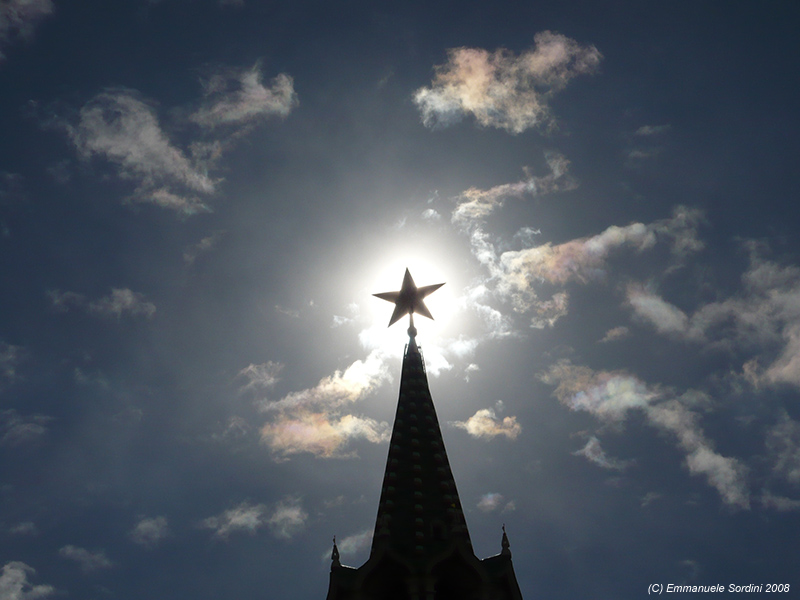
at least, when back to Italy, I'll have a nice memory and something to laugh at. The pickiest among you, my dear readers, will have already noticed that the occulting shape is not exactly the same as the Moons disk, but as they say beggars cant be choosers!
On July 31st we finally land in Barnaul after a very uncomfortable (and overdue) overnight flight from Moscow. As if to remind us that the eclipse chasers job is not an easy one, Mother Nature treats us with the usual cloudy and stormy weather. The only significant difference from Moscow is the much higher temperature (around 30 °C), and this makes it feel all the more uncomfortable. In the afternoon we hunt for a suitable observing spot: after much exploration, we find a restaurant with a rather promising wide terrace on the banks of sluggish Ob river. Much to our surprise, around 4 pm local time the Sun starts peeping into the cloud blanket, and by 5.30 pm it has almost cleared up completely: if the eclipse was scheduled for today, it would be perfectly visible! Is it a sign of hope or just fate making fun of us? Of course our joy doesnt last long, as later in the evening a thick bank of clouds rolls in again. In the meantime, we continue our reckless survey of online meteo websites, which is no easy task here because of the rather poor accessibility to the Internet: the forecast does not show the slightest sign of improvement, i.e. always lousy weather with Novosibirsk having slightly better chances.
And finally starts E-Day, Aug 1st, with the good, ol' cloudy and muggy weather, and even a very quick shower. Our faces are now those of despair, and in particular for the most die-hard eclipse chases, like myself . At some point some of us (including myself) even consider the possibility of renting a car and rushing to Novosibirsk, where the situation looks more promising: but we give up very soon, because mobility around here is quite difficult due to poor infrastructure (Novosibirsk lies at a mere 200 km to the North, but it takes almost four hours to get there with such lousy roads), language problems (everybody speaks nothing but Russian around here), and a very high level of bureaucracy. So we just decide to visit Barnaul (which is for sure no big deal, being just a industrial city with a very recent development), and to take our chances of seeing the eclipse at the previously chosen spot.
So, around 2 pm, just after lunch, we start assembling our rigs: the setup phase is very busy and, to some degree, cheerful in spite of thick cloud cover still lingering above us. Here are a few pictures:
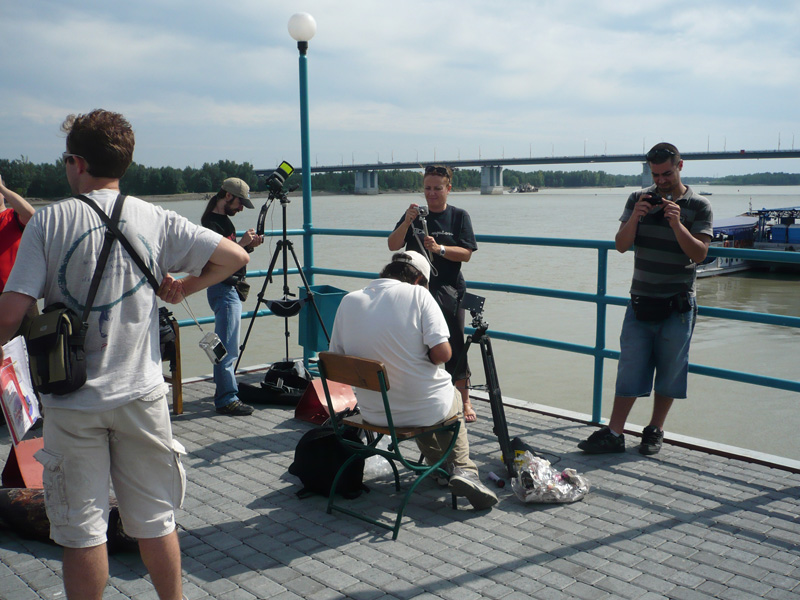
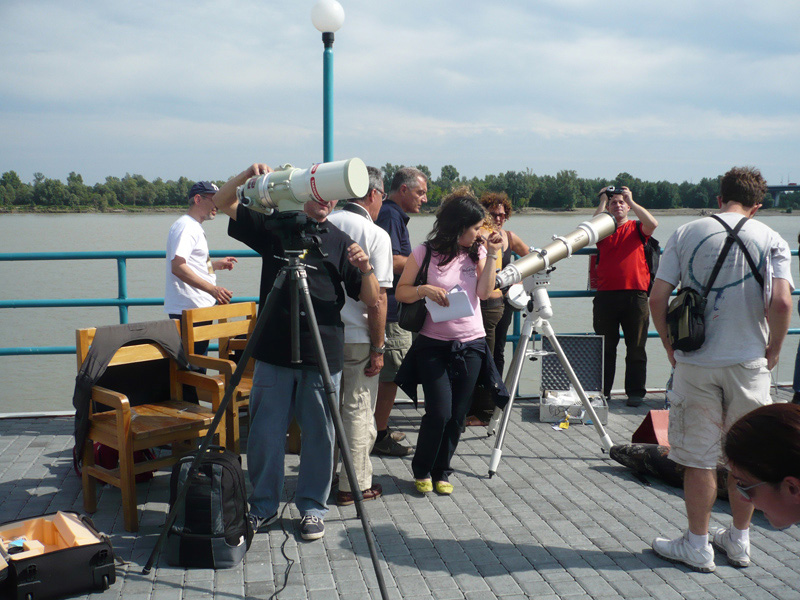
Below you can see me next to my setup, consisting mainly of a small refractor (Night Technology 80 f/6 riding a small equatorial mount) used with a digital camera (Canon EOS 350D, aka Digital Rebel XT), and an analog one (Nikon F3) lying on a fixed Manfrotto tripod:

please note the very fashionable and classy sling with I have to wear because of my shoulder dislocation :-)
Around 3 pm local time, Mother Nature decides to surprise us. The cloud cover starts to break (you can already see the sun casting dim shadows in the above pictures); meanwhile a rather strong northwesterly wind sets in, and a mere one hour later it has almost cleared up completely, with only a few, lonesome cirrus clouds. Of course we are standing in awe, and no word can fully describe our happiness. Just one hour left for the big show, what else could possibly happen to us?
Now you readers will say: you lucky men, youve made it in the end, what else could you possibly be wishing for? Come on, the time has come to show us your pictures! Nope, just be a little patient, coz there was enough time left for Mother Nature to play a last dirty trick on us, which almost jeopardized our observation of the eclipse.
The local circumstances of the eclipse calculated for our observation point are as follows:
totality was expected to last about 2 min and 16 seconds. When the Moon starts to eat away at Suns disk, its around a quarter to five pm local time and the sky is mostly clear.
A whole hour before the start of partiality and a good part of it pass by without any particular problem, with the sky being traversed only by some sluggish cloud every now and then: however, as time inexorably ticks away, we notice a low cumulus bank rolling in from the West, i.e. exactly from where the Sun is located. Meanwhile, the wind intensity increases to an uncomfortable level, whereas the ambient light dims considerably, as our Star is slowly being occulted by the Moon.
Around 15 minutes before totality, and with the light dimmed down to an awkward twilight, heres the bad news: a cumulus cloud is heading for the eclipsed Sun, and from its apparent direction and velocity we soon find out that it will eclipse the eclipse exactly during totality. At this point, I think you may understand our despair and anger: all this hassle just to end up being tricked by a pesky cloud!!
A few minutes later, that damned cloud takes the big show away from our eager sight exactly when the Moon is seizing the very last ray of light, and darkness sets in. Around forty never-ending, gloomy seconds pass by, during which in the secret of this awe-inspiring darkness we all hope for a miracle to happen, for fate cant be so mean to us as to prevent us from enjoying this wonderful event!
Finally, most likely thanks to the lack of solar radiation (which is known to be a very effective contributor to cloud formation), our dear friend decides that its time to scram away: so, after a few more seconds can we behold the grandiose view of totality, and we all yell out our happiness! We start shooting pictures like crazy, but this ephemeral view ends in the blink of an eye, as a very thin (and very bright) crescent of Sun peeps back from behind the Moon to the right-hand side. Now theres no doubt that totality is really over: the unusual twilight slowly turns into a dim, late-afternoon ambient light, and all colors regain their usual look.
The not-so-funny thing about this misadventure of ours, is that the pesky cloud was at very low elevation, so because of the parallax effect any place lying even at a mere 2 km away was not affected by the clouds presence. For example, when Daniele Cossu (an Italian amateur astronomer who traveled by motorbike all the way to Barnaul, after a 7000-plus km ride) realized the serious risk of being clouded out, he rushed a very short distance away (around 1 km), which proved sufficient to view the whole eclipse. The same applies to the nearby bridge over the Ob river, where traffic stopped for a couple of minutes with everybody staring up at totality. The whole thing puzzled me so much, I managed to screw up the acquisition of the third contact as a clueless rookie, thereby missing out on the opportunity to photograph the diamond ring!
Nevertheless, I came back from Russia with a fair loot of pictures. Heres a sampler of those taken with my Canon EOS 350D DSLR (set at ISO 200 and used with a 5.0-density Baader Astrosolar filter for the partial phase) and the 80-mm f/6 Night Technology refractor:
Recall that earthshine is a phenomenon whereby the un-illuminated part of the Moons disk is not completely pitch-dark, but glows with a very dim dark gray hue: this is normally visible until first quarter, especially under very clear and crisp skies. This faint glow is caused by sunlight, which is reflected off the Earths atmosphere and illuminates the Moon. Although not so easily, it can be pictured during solar eclipses, but given its very low contrast, it calls for patience and rather good image processing skills to show up.
Below is a nine-image mosaic taken roughly at regular intervals: 17:13, 17:23, 17:33, 17:43, 17:48 (totality), 17:53, 18:03, 18:14, 18:23 local time. Exposure times: 1/2000 s for the partial phase, 1/30 s for totality.
Last, one picture which I personally find quite interesting, both for its look and because its the only picture taken on film. By using a camera that allows multiple exposures on the same frame, the good ol Nikon F3, I managed to take twenty-five shots, around every five minutes. Other data: 50-mm lens @ f/8, Fuji Reala 100 film, 1/1000 s exposure time with a 5.0 D Mylar filter for partiality, and one 1-s exposure for totality:
In this picture at least two remarkable things can be seen. Firstly, the small white dot to the upper left from the eclipsed Sun is Mercury; then, just above our star lies the pesky cloud that almost screwed our eclipse observation. If you hover around on the picture with the mouse pointer, youll be able to see the legend superimposed on the original picture. One final note: had the sky been clear, also Venus would have been visible, farther to the Northeast.
Unfortunately, I had no time to make any measurements of the ambient parameters (i.e. temperature, humidity, etc), nor to play around with the strange-shaped shadows than can be typically observed during solar eclipses. I just remember I felt a drop in temperature, even if there was no need to put on any warmer clothing. and a sudden drop in wind speed. Anyway, the weather stations of Novosibirsk and Barnaul airports, in spite of their low sampling rate (every hour), a slump in temperature ranging from 3 to 4 °C was reported around 6 pm local time:
Temperature and wind speed graphs for Novosibirsk and Barnaul, dispatched as METARs
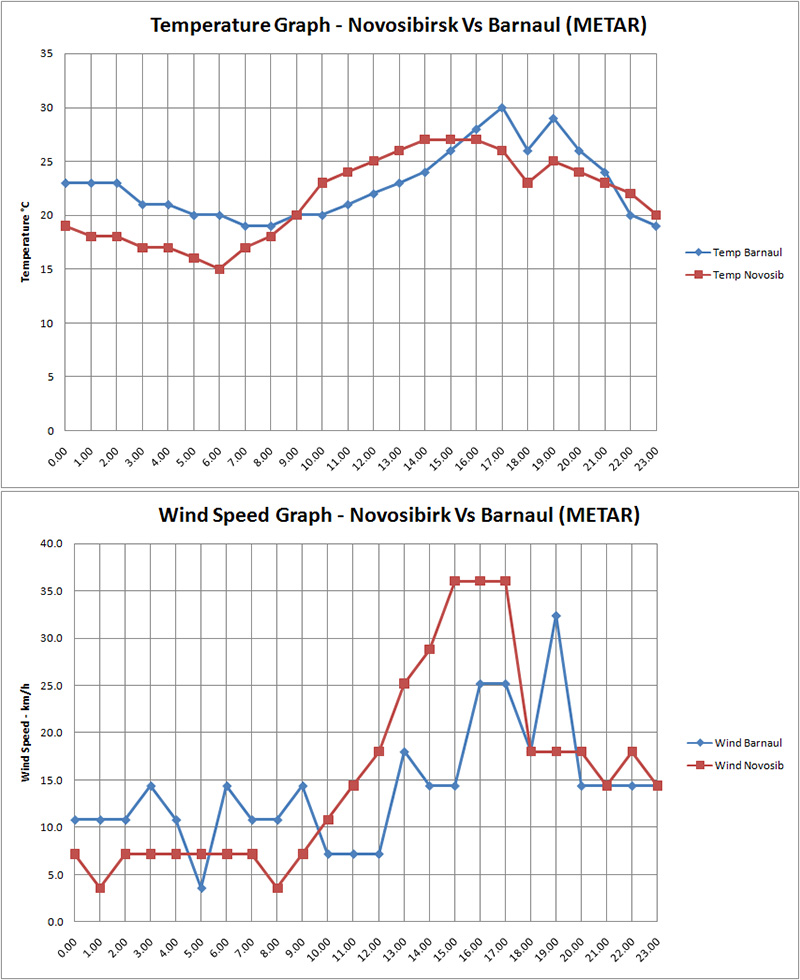
which actually shows the (reasonably) correct behavior of both weather stations. The temperature measurement was made around 10 minutes after totality, so it may have had a small chance to increase somewhat before the actual measure was made. As for humidity, there isnt much to say: it stayed at high values in the morning because of the cloudy and damp the weather we experienced until early afternoon. Anyway, neither weather station reported any significant variation in the dew point.
Just a few minutes before 7 pm, the Moon finally leaves the Suns disk of the remaining tiny dent, and the last hectic clicks from our cameras seem to be trying to take the clock back. Of course there is no way that we can do this, but thats probably the main reason why these wonderful phenomena are so special and fascinating!
In the end, we are very pleased with our final results, especially because of the huge risk we ran of being clouded out. So we all take a big sigh of relief and it all ends up in a very cheerful (and, needless to say, vodka-based ) toast, as shown in the picture below:
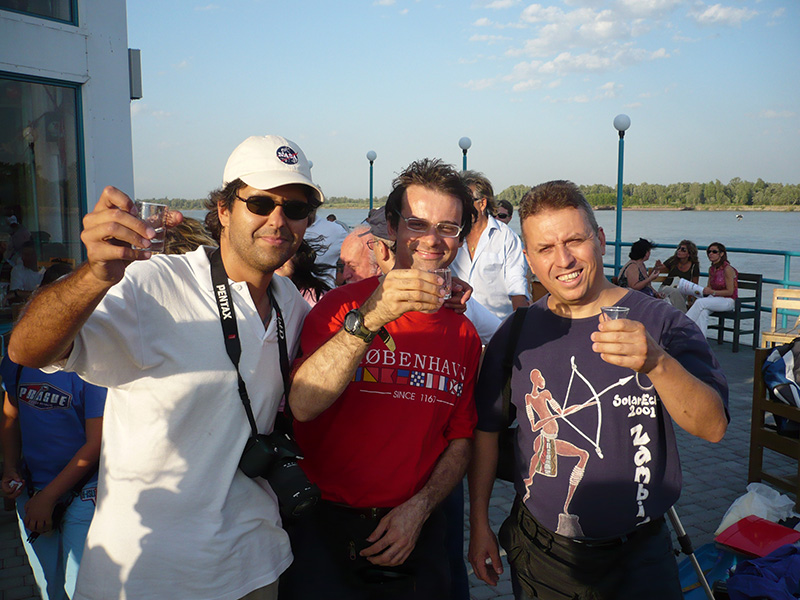
To top off, the day ends with an outdoor dinner in the very same restaurant and, of course, under a crystal-clear sky!
Super-duper group picture of the participants in the Siberian tour. Please note Daniele Cossu on his motorbike, who traveled all the way to Barnaul! (Picture by Alberto Villa)
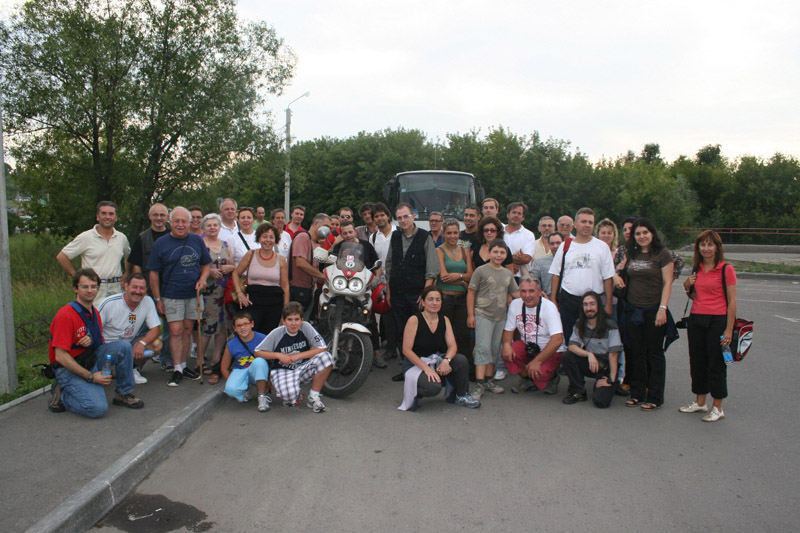
The following day, August 2nd, our group splits up: some go back to Italy, while the rest (including myself) head to Saint Petersburg for the planned tour extension. In spite of the (surprisingly) godawful weather, Russias second largest city will treat us with magnificent views of its canals, palaces, villas and museums.
The very last day, August 5th, our trip is really over: the time has come to kiss everybody goodbye, and fly back to Italy, each one to his/her hometown. I wish to thank my wonderful travel mates, who always volunteered to help me lug around my heavy equipment. And of course, a very special hug is for our beloved friend, the Moon, without which we couldnt have witnessed this wonderful phenomenon!

Leave a comment